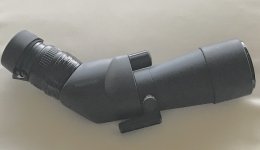I’ve seen many posts about forum members putting astro eyepieces on their spotting scope, or updating/upgrading their sometimes old spotting scope with new eyepieces. The latter either of the original brand (e.g.switching to recent wide field eyepiece with better coatings) or from other brands (e.g. putting an Opticron eyepiece on an older Kowa scope).
The appearance of wide angle zoom eyepieces (new optical formulas/design) probably has been one of the reasons, but I guess not the only reason or evolution in the last decades.
This has made me wonder : how (much more?) important is the eyepiece as opposed to the scope’s body in defining the combined optical quality? Sharpness, contrast, brightness...?
: how (much more?) important is the eyepiece as opposed to the scope’s body in defining the combined optical quality? Sharpness, contrast, brightness...?
Is there much less difference between bodies of different ages and price levels (excluding the cheapest or faulty ones) than there is between eyepieces?
If so, is this due to a higher optical complexity of eyepieces or their larger number of optical elements or glass-air surfaces, making them benefit more from technical evolutions (e.g.improvements in coating technology)?
Of course, a lousy/bad scope body won‘t allow a great eyepiece to really shine, it will depend on the specific body and eyepiece, and you cannot exactly quantify it, but can anybody share his/her knowledge and experience about this based on optical/technical knowledge and/or on hands-on experience with such upgrades and combinations of bodies and eyepieces, old and new, cheaper or more expensive etc.?
...
Or do we mainly talk more about putting new eyepieces on older scopes than we do about upgrading to newer bodies while keeping older eyepieces, just because new eyepieces are much cheaper than new bodies...?
The appearance of wide angle zoom eyepieces (new optical formulas/design) probably has been one of the reasons, but I guess not the only reason or evolution in the last decades.
This has made me wonder
Is there much less difference between bodies of different ages and price levels (excluding the cheapest or faulty ones) than there is between eyepieces?
If so, is this due to a higher optical complexity of eyepieces or their larger number of optical elements or glass-air surfaces, making them benefit more from technical evolutions (e.g.improvements in coating technology)?
Of course, a lousy/bad scope body won‘t allow a great eyepiece to really shine, it will depend on the specific body and eyepiece, and you cannot exactly quantify it, but can anybody share his/her knowledge and experience about this based on optical/technical knowledge and/or on hands-on experience with such upgrades and combinations of bodies and eyepieces, old and new, cheaper or more expensive etc.?
...
Or do we mainly talk more about putting new eyepieces on older scopes than we do about upgrading to newer bodies while keeping older eyepieces, just because new eyepieces are much cheaper than new bodies...?





